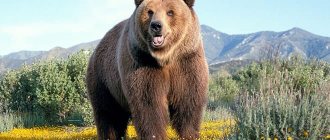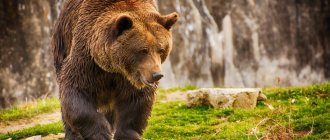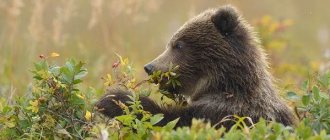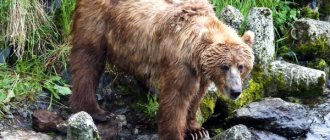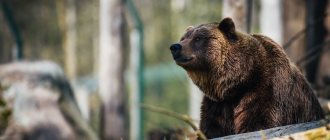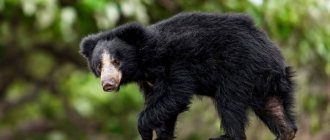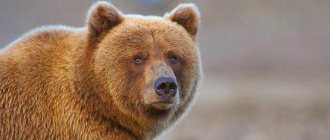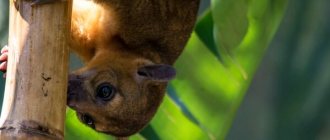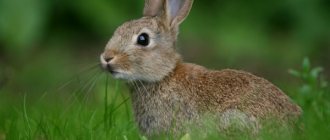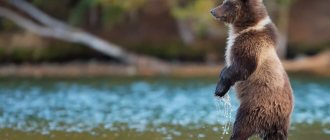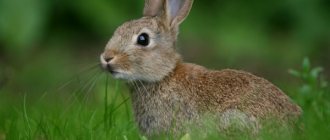If you consider the bear to be a dangerous predator that prefers to feed on mammals, then you will be disappointed. In fact, most of a bear's diet consists of plant-based ingredients. These can be any gifts of nature: berries, plants, roots, etc. And if the animals that live in zoos do not have to get food, then wild animals are forced to spend a lot of time looking for food and eating pasture. Fortunately, the forest provides the clubfoot with everything he needs.
Appearance
All subspecies of brown bear have a well-developed, powerful body, a fairly large head with small eyes and rounded ears, and high withers. The tail is short (from 6.5 to 21 cm). Strong paws with powerful non-retractable claws up to 10 cm long, five-toed feet, quite wide. The appearance of the subspecies varies significantly. Males are approximately one and a half times larger than females.
Dimensions
The individuals inhabiting Europe are the smallest, reaching two meters in length and weighing 200 kg. Brown bears living in central Russia are larger and weigh about 300 kg. The largest are grizzlies and Far Eastern bears, their length reaches three meters and their weight reaches 500 kg or more.
Color
What a bear looks like and what color its skin is depends on its habitat. There are bears from light fawn to black and blue. Brown fur color is considered standard.
Grizzlies native to the Rocky Mountains have white fur on their backs at the tips, creating a grayish tint. Brown bears living in the Himalayas have a completely grayish color, while those living in Syria have a light, brownish-red skin.
Brown bears shed once a year, from spring to autumn. Spring molt is often separated from autumn molt. Spring molting occurs most intensely during the rut and lasts quite a long time. The autumn period proceeds almost unnoticed and ends by the time the bears’ winter hibernation begins.
Habitats
The brown bear inhabits almost the entire forest zone from western Russia and the forests of the Caucasus to the Pacific Ocean. It can also be found in Japan on the island of Hokkaido, in some Asian countries, in Europe, Canada and in the northwestern states of America.
For life it chooses forested areas, with windbreaks and shrubs, prefers coniferous forests. It can wander into the tundra or settle in high mountain forests, with an undergrowth of edible plants.
The habitat is not tied to a specific place; often the feeding places and the bear’s home are located far from each other and the bear has to make long journeys during the day.
Where does the brown bear live?
The brown bear is a forest animal. Lives in dense forests with dense green vegetation. Places such as the tundra, taiga, and mountain ranges are ideal habitats for clubfoot predators. Previously, the habitat ranged from England to China and Japan. Today, due to the extermination of the species, its habitat has decreased significantly. Bears remain only in Russia, Alaska, Kazakhstan, and Canada. Under natural conditions, one bear occupies a territory of 70 to 150 kilometers.
- Eastern part of the Siberian taiga;
- Mongolia;
- Pakistan;
- Iran;
- Korea;
- Afghanistan;
- China;
- The foothills of the Pamir, Tien Shan, Himalaya mountains;
- Kazakhstan.
Almost all bears live in areas near open water sources.
Habits and lifestyle
The brown bear is a loner. Males live separately, and females raise cubs. Each adult has its own territory, the size of which can reach several hundred square kilometers. Males “own” a much larger territory than females. The boundaries of the territory are marked by scratches on the trees and the scent of the owner.
The habits of bears are typical of a predator. During the day, as a rule, animals rest, choosing secluded areas among grass or bushes. They go out in search of food in the morning or evening. Despite poor eyesight, bears are excellent at navigating using their sense of smell and hearing.
Despite its impressive dimensions and apparent clumsiness, it is a fairly agile and fast animal, capable of climbing trees, swimming and running at speeds of up to 60 km/h.
Natural enemies
The bear, being a real forest king, has no enemies among animals. Any animal that notices a healthy silhouette will try to hide from sight as quickly as possible without entering into conflict.
Interesting fact : cases have been recorded of wolves running away in whole packs at the sight of a bear. Even despite their numerical superiority, other predators prefer not to come into conflict with this beast.
But the bear, in turn, is a walking nuisance for almost all animals that meet on its way. Depending on his mood and degree of hunger, he can attack any animal.
Perhaps the only one who dares to attack a bear is a person. Since the animal grows to large sizes, one individual is capable of producing tens of kilograms of meat and a large, warm skin.
Nutrition
The diet of a brown bear is very diverse, because bears eat almost everything. Its main diet consists of plant foods: berries, nuts, acorns, stems, tubers and roots of plants. If possible, he will not miss the opportunity to wander into the fields to feast on oats and corn. It also eats various insects, frogs, lizards and rodents.
Adults hunt young moose, fallow deer, deer, roe deer and wild boar. A large predator is capable of breaking the backbone of its prey with one blow of its paw, then hides the carcass, covering it with brushwood, and guards it until it is completely eaten. For the Far Eastern brown, the main diet in the summer-autumn period is salmon going to spawn.
When the food supply is insufficient, bears often destroy apiaries and attack livestock.
These animals have amazing memory. Having found mushrooms or berries that bears eat in the forest, they remember the places and then easily find their way to them. The lifespan of a brown bear in the wild largely depends on adequate nutrition.
Attacks on people
Hunger drives the bear from the forest to places where people live. The animal often attacks livestock. If a predator is very hungry, it is capable of eating its cubs and even humans.
Attacks on people happen, although rarely, but regularly. Risks increase during the rutting season and the lack of food. The most dangerous are connecting rod bears that woke up after hibernation or for some reason did not lie down in a den. If a bear has not had time to gain the required amount of fat, then it poses a serious danger. In especially hungry times, any individual can become a connecting rod.
The beast loses fear and attacks everyone it sees. He seems to be losing his mind. Having noticed a person, the connecting rod will begin to quietly pursue him and wait for the moment to attack from behind. Sometimes individuals act actively, standing on their hind legs and approaching with impressive jumps.
So, in 2006, a Yakut family was attacked by a connecting rod in the courtyard of their house, which killed the woman. The owner of the house mortally wounded the animal with a cold weapon. The bear was severely exhausted. His weight reached half normal.
When picking berries and mushrooms, it is better to create noise around you. So, the bear will not be afraid of an unexpected meeting and will not attack a person. The main thing is not to provoke the animal. You cannot run away suddenly and turn your back. It is prohibited to take away prey or encroach on territory and offspring. A close encounter with a clubfooted lout can turn into a fatal mistake.
Reproduction
How do bears reproduce? The mating season begins in May and lasts a couple of months. The rut is active, accompanied by fights between males and roaring. After 6-8 months, cubs are born. Bear cubs are born in the middle of winter, when the bear is hibernating.
Cubs are born weighing only 400-500 grams, blind, with sparse hair. As a rule, there are 2-4 cubs in a litter. For more than a year after birth, they feed on their mother’s milk, but immediately after leaving the den, the mother begins to accustom them to various foods.
The cubs and their mother live for three to four years, then they separate and begin to live independently. Females reach sexual maturity in the third or fourth year, males develop 1-2 years longer.
Hibernation
From mid-summer and throughout autumn, bears actively prepare for hibernation, feeding heavily and accumulating fat. The hibernation of a bear differs from the hibernation of other mammals; it is not suspended animation, but simply a sound sleep, during which neither the breathing nor the pulse of the animal changes practically. A bear in hibernation does not fall into complete stupor.
Preparation
Shelters for the winter are arranged in remote and dry places, under tree roots or under windbreaks. The clubfoot can dig a den on its own, or it can occupy a crevice in the mountains or a small cave. Pregnant females build a spacious and deep den, insulating it from the inside with moss, leaves and spruce branches.
One-year-old cubs always spend the winter in their mother's den, often joined by two-year-old cubs. Adults lie in the den one at a time.
Duration of hibernation
How long does a bear sleep? It all depends on weather conditions and other factors; the brown one can hibernate for up to six months.
A bear's hibernation in winter and its duration depend on the weather, age, gender, state of health and the amount of fat gained during the summer-autumn period. So, for example, an old individual that has gained enough fat will go into hibernation long before the snow cover falls, and young individuals go to the den only in November or December. Pregnant females settle in for the winter first.
Lifestyle
When considering the question of what a brown bear eats, it is important to separately note its lifestyle. Animals prefer to settle in a den for a long time, and they only move a few kilometers away from it. They search for food and hunt nearby, while they are strongly attached to their place of residence and are ready to protect it from strangers.
If there is no food, then you have to wander so as not to die of hunger. An animal can travel several hundred kilometers in order to find more comfortable housing.
As soon as the cold weather sets in, a person should be wary of meeting a bear on his way. The fact is that the predator becomes angry and quite aggressive, so it can attack a person and tear him to pieces.
It is important to know that not all individuals hibernate; some continue to be awake. Those who have not had time to accumulate a lot of fat in order to rest peacefully in a den do not fall asleep. On rare occasions, animals wander into the village and kill livestock.
Those bears that were hibernating wake up in the spring and take a long time to recover from sleep. Their strength is slowly returning, and the animals begin to enjoy the warmth. From this moment they begin to hunt again. In May, they feed mainly on young grass and can easily do without meat.
As for the cubs, only the mother provides food for them. Males are indifferent to their offspring and partners, so they will not help. Gradually, the young animals will mature and develop, starting to look for food on their own.
The bear is a dangerous predator that needs to be especially careful in winter. If he does not eat normally, then he will become angry and bloodthirsty. At the same time, on a full stomach, animals become cute and playful, but this only applies to young animals. In any case, food is important for bears, since without it they cannot exist.
